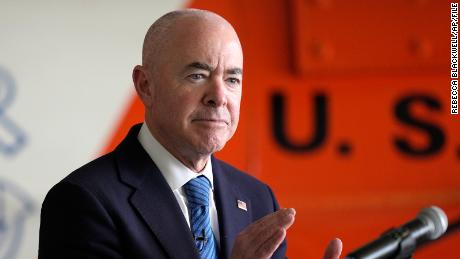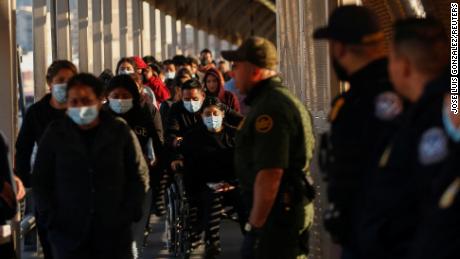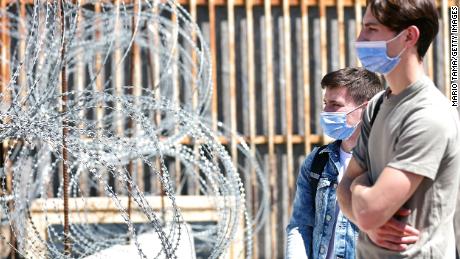But what is actually happening? How is this different from the way things were handled in the past? And what could happen next?
Here’s a look at some key questions and answers about the controversial policy and what’s happening on the ground.
In the early days of the coronavirus pandemic, the CDC issued a public health order on March 20, 2020, that officials said aimed to stop the spread of Covid-19. The order allowed authorities to swiftly expel migrants at US land borders, and it’s been extended multiple times. The policy is widely known as Title 42,
for the portion of US code that allowed the CDC director to issue it.
On April 1 of this year, the CDC
announced plans to terminate the order,
stating that it’s no longer necessary given current public health conditions and the increased availability of vaccines and treatments for Covid-19. The policy is scheduled to end on May 23.
A federal judge in Louisiana on Friday for now blocked the administration from ending the policy, thwarting plans to terminate it. Judge Robert Summerhays of the Louisiana Western District Court
had previously temporarily blocked the administration from winding down the public health order before the termination date.
Why is it controversial?
After the Biden administration announced it was lifting the policy, a debate erupted over whether ending it is justified, and whether officials are prepared to handle
an expected increase in migrants at the border.
GOP lawmakers running for reelection this fall have been
using the repeal of Title 42 as a talking point to attack Democrats on immigration. Republicans who’ve been vocal about the importance of ending other pandemic restrictions have described ending Title 42 as a dangerous mistake.
Democrats from swing states facing tough reelection battles have also criticized the move,
arguing the administration doesn’t have a clear plan in place.
But controversy over Title 42 didn’t begin with the Biden administration’s recent announcement of plans to roll back the policy.
The border restrictions were controversial from the moment the Trump administration announced them. Immigrant rights advocates
argued officials were using public health as a pretext to
keep as many immigrants out of the country as possible. Public health experts
also slammed the policy, saying it wasn’t justified by the circumstances.
Leading Democrats like Senate Majority Leader Chuck Schumer have
called the policy “draconian” and “inhumane.”Many advocates expected President Biden would lift the order when he took office, given his campaign promises to build a more humane immigration system. Instead, his administration extended the policy more than a year into his presidency and defended it for months in court.
What’s been happening at the border since this policy began?
Under Title 42, authorities expelled migrants at the US-Mexico border more than 1.8 million times in just over two years,
according to US Customs and Border Protection data. The US asylum system effectively screeched to a halt, with migrants who claimed they were fleeing persecution blocked from making their case —
something that US and international law says they should have a chance to do.
In recent months, the policy drew renewed attention when authorities at first were using it to turn away Ukrainians at the border, then largely
started granting exceptions that
allowed thousands of Ukrainians seeking refuge to cross.
Advocates argued a racist double standard was at play as many migrants from Central America and Haiti continued to be turned back under the policy; officials denied that accusation and said each exemption is granted on a case-by-case basis.
Migrants encountered under Title 42 are either expelled to their home countries or into Mexico, where human rights advocates say they have documented many abuses. Since Biden took office,
Human Rights First says it’s identified nearly 10,000 cases of kidnapping, torture, rape or other violent attacks on people blocked or expelled to Mexico under Title 42.
But migrants haven’t stopped trying to cross the US-Mexico border — a detail people on both sides of the debate are pointing to, with very different arguments about what it shows.
US Customs and Border Protection says arrests along the US-Mexico border increased in March, when there were more than 220,000 migrant encounters. CBP says it’s apprehended more than 1 million people so far this fiscal year, which began on October 1.
To some extent, migration is seasonal. And the number of people trying to cross the border tends to go up in the spring. Experts also say
the economic hardships of the pandemic have further intensified migration trends.
Those who support Title 42 point to border arrests as they argue how essential the pandemic policy is for blocking illegal immigration. Those who oppose the policy argue official statistics about encounters at the border inflate the severity of the situation, because the data include people crossing the border multiple times. They argue Title 42
has actually caused more border crossings.
What would lifting Title 42 do?
Officials have indicated they expect lifting Title 42 would prompt a new influx of migrants at the border. They’ve said they’re preparing for different outcomes, including a worst-case-scenario possibility that up to 18,000 migrants a day could try to cross the border.
If the order is lifted, the way migrants are processed at the border is largely likely to go back to how it was before 2020. Under that system, migrants are either removed from the country, detained or released into the US while their cases make their way through immigration court.
This much is clear: The border is once again the epicenter of major political debate, and the lives of thousands of people hang in the balance.
This story has been updated to reflect recent developments.
CNN’s Priscilla Alvarez, DJ Judd, Rosa Flores and Daniella Diaz contributed to this report.










More News
Last of Escaped Zebras Captured With White Bread, Oats and ‘Positivity’
The Bleak Life of a Deposed President and His Wife, Held Captive
Frank Stella, Towering Artist and Master of Reinvention, Dies at 87